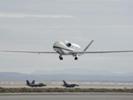
Light Jets, UAVs Need Collision Avoidance Systems: Eurocontrol
Two studies commissioned by the Brussels coordinator of air traffic control in Europe predict growth and potential conflict from unmanned aerial vehicles and say they need to be equipped with technology comparable to that of manned aircraft.
Eurocontrol's summer 2010 Technical News e-newsletter, posted July 1, includes an article discussing the safety concerns posed by very light jets and unmanned aerial vehicles (UAVs), which are not equipped with the Airborne Collision Avoidance System II technology that is mandatory in Europe for all civilian fixed-wing, turbine-engined aircraft with maximum takeoff mass above 5,700 kg or minimum passenger seating configuration above 19. The safety benefits of ACAS II decline as the population of unequipped aircraft increases, according to the Brussels-based agency that integrates air traffic control throughout Europe. Its full name is the European Organisation for the Safety of Air Navigation.
Eurocontrol commissioned two studies of the problem. The first concluded the ACAS II mandate should be expanded to include all civilian fixed-wing, turbine-engined aircraft with a maximum cruising speed above 250 knots, and it found no benefit would be gained by equipping very light jets with an earlier version of the airborne collision avoidance system that helps pilots acquire other aircraft visually but does not produce resolution advisories. That system, in fact, would be problematic because enhanced visual acquisition increases the likelihood two aircraft will employ incompatible avoidance maneuvers.
The second study showed UAVs need to have a collision avoidance capability that is comparable to ACAS on manned aircraft. While unmanned aircraft operations now take place in specifically reserved airspace, their use is likely to increase, it found, so UAVs must pose no more risk to people and property in the air or on the ground than manned aircraft, and they will be treated like any other aircraft by air traffic controllers.
UAV civilian use in the United States includes NASA's program, one element of which is the Global Hawk plane, which successfully completed its first scientific flight in April 2010. Global Hawk can fly above 60,000 feet and as far as 11,000 nautical miles, according to NASA.
Another article in the newsletter, "Safety Culture Programme Gathers Momentum," shows how Eurocontrol's safety culture approach is being embraced by Air Navigation Service Providers across Europe. Based on research done by Aberdeen University UK, the approach employs surveys that target safety improvements in reporting, organizational learning, risk awareness, teamwork, commitment and involvement in safety, and trust in the safety process.